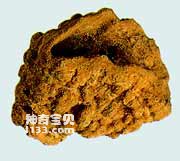Sponges are the simplest structure and the most primitive form among multicellular animals. They have appeared before the Cambrian and have continued to thrive until modern times. Sponges evolved from single-celled animals. Their cells have differentiated but have not yet formed tissues and organs. There are single sponges and groups of sponges, with various shapes. Single sponges have shapes such as goblet-shaped, bottle-shaped, spherical, and cylindrical. The body wall of sponges has many holes with water channels running through them. There is a central cavity in the body, and the upper end opening forms the water outlet of the entire individual.
Most sponges have skeletons. There are two types of bones. One type is small needle-like, spiny calcium or siliceous bones, called spicules; the other type is filamentous bones composed of organic matter, called bone filaments.
Bone filaments are not easily preserved as fossils, while bone spicules can form fossils. Some bone spicules can intersect with each other to form a skeleton. Such a skeleton can maintain the original shape of the sponge body after fossilization.
Scientists classify sponges mainly based on the nature and composition of their bones. Sponges can generally be divided into four classes: Calcareous Sponges, Common Sponges, Hexaspongees and Heterosponges.
There are more than 1,000 genera of fossil sponges recorded by scientists. The earliest representatives include calcareous sponges found in the Precambrian strata of the Congo in Africa, and silicon sponges found in the mid-Proterozoic strata of Karelia and the Yenisey Mountains in Russia. Spicules of sponges and sporadic representatives from the Precambrian in southern my country. Since the Cambrian period, many representatives of the three classes of common sponges, hexasponges and heterosponges have appeared. Among them, the heterosponges became extinct after the middle Triassic. Calcareous sponges only began to appear during the Devonian period.

sponge fossil
Sponges have lived in a wide range of areas since ancient times, so their fossils can be preserved in a variety of rocks such as limestone, sandstone, phyllic chalk, and deep-water claystone. Because sponges in the Paleozoic and Mesozoic era often lived in symbiosis with typical shallow-sea animals such as corals and brachiopods, scientists generally believe that they mainly lived in shallow seas at that time. The living areas of Cenozoic sponges are similar to those of modern times, and the general trend is that their adaptive range is getting wider and wider.
Except for the uniaxial rolling sponges in the class Sponges, all modern sponges live in the ocean. Calcareous sponges can be distributed from coastal waters to the deep sea at a depth of 2195 meters, but the main distribution area is in water depths less than 100 meters. The distribution area of marine common sponges is from coastal to semi-deep sea. Six-shot sponges basically live in deep continental slopes and the deep seabed below. They are basically not found in sea areas with water depths less than 90 meters. Only a few molecules can be found in the water depth range of 90 to 200 meters; only in There are a small number of six-shot sponges living in the shallow waters of Antarctic waters.
Modern sponges can be found in oceans at all latitudes on Earth. Common sponges are mainly distributed in warm oceans and are less common in high latitudes. Six-shot sponges are concentrated in tropical and subtropical seas, and are especially abundant in Indonesia, Philippine waters and the South China Sea. A few molecules are also distributed in waters near the Antarctic. The remaining calcareous sponges are distributed in warm sea areas.
animal tags: sponge
We created this article in conjunction with AI technology, then made sure it was fact-checked and edited by a Animals Top editor.